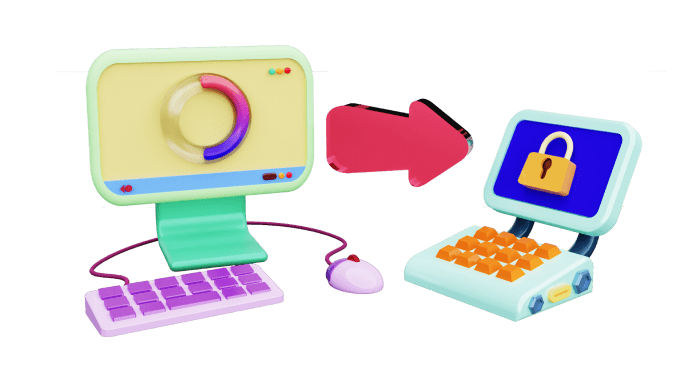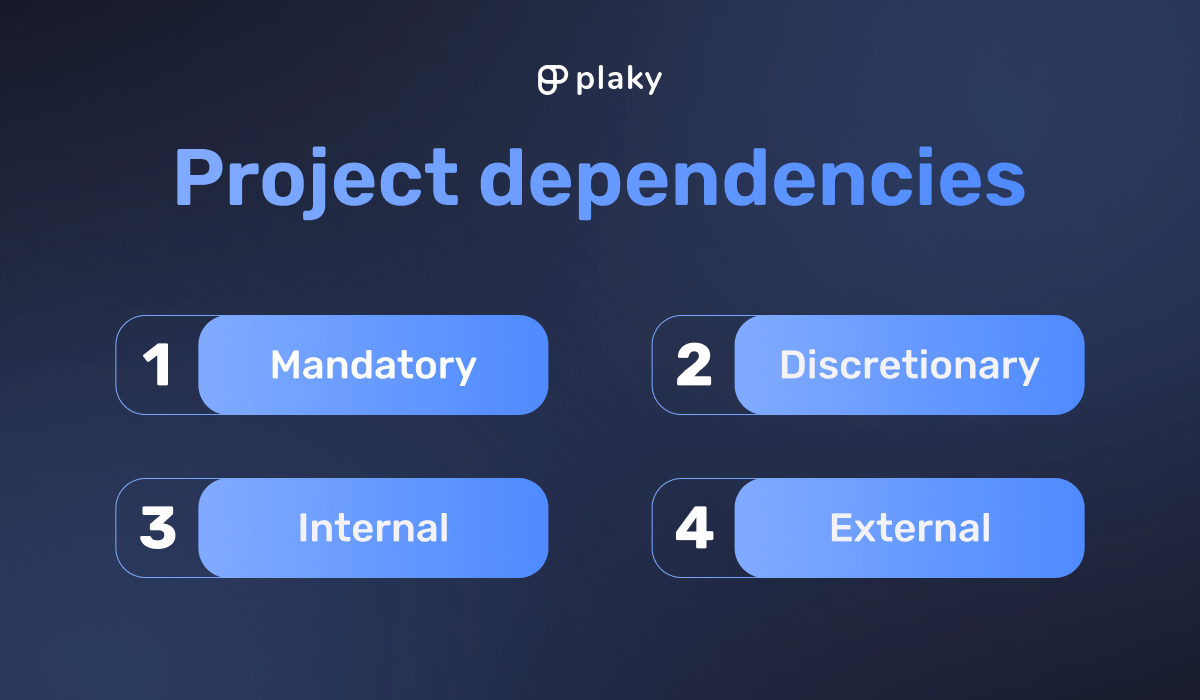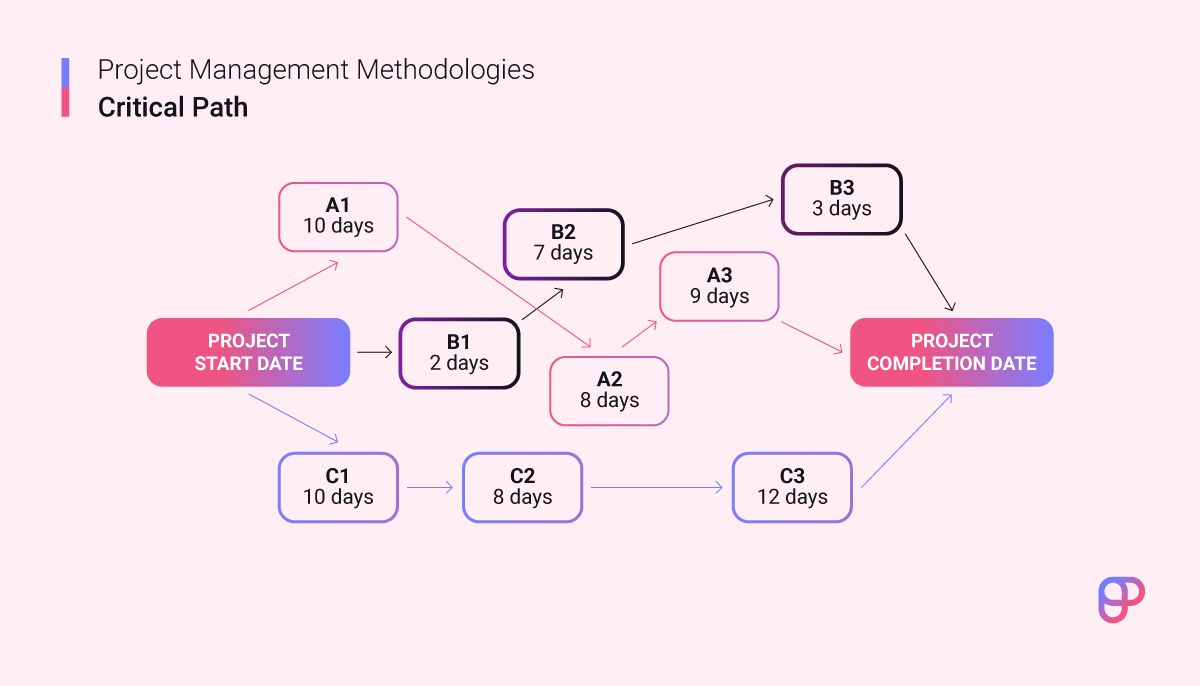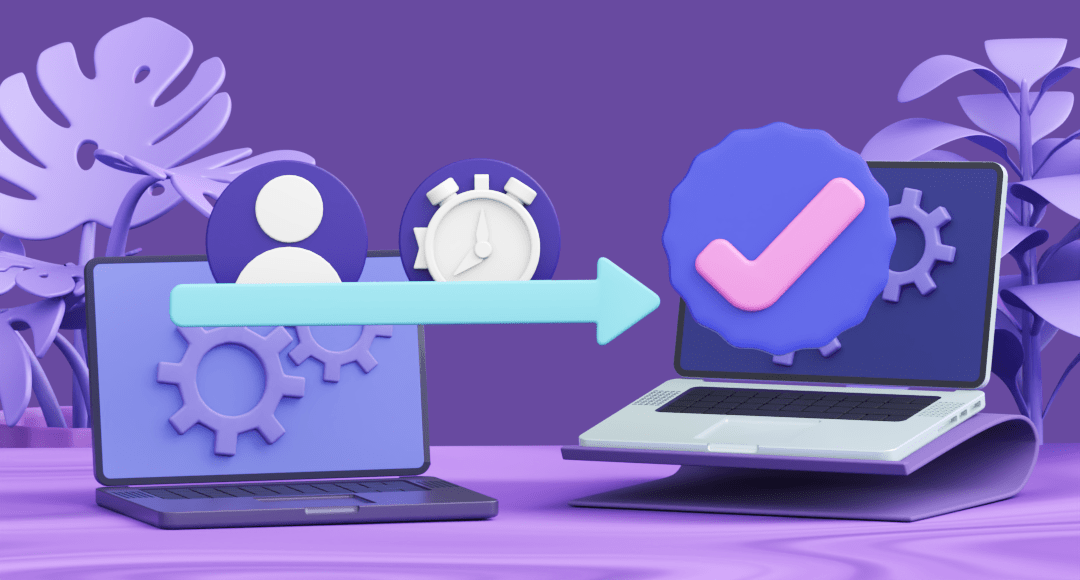Dependencies in Project Management: Types + Examples
A project is not an isolated event — it consists of various interconnected tasks.
Therefore, pinpointing and addressing dependencies between them is one of the most critical steps for successful project management.
In this guide, we will define the term “dependency” and identify different types of dependencies in project management. Moreover, we will explain how to manage dependencies and provide examples to help you better understand the matter.

- Dependencies are relationships between tasks that determine their order in a project.
- Identifying and recording dependencies is vital for organizing work and making a project schedule.
- The 4 main types of dependencies are: mandatory, discretionary, internal, or external.
- Creating a dependency diagram gives you a clear visual depiction of project dependencies.
- It’s important to communicate with stakeholders and explain the dependencies between tasks and how they can affect the project.
Table of Contents
What are dependencies in project management?
Dependencies in project management are relationships between tasks that determine their order in a project.
Tasks can be predecessors and successors to each other. Furthermore, you can have multiple predecessors for one successor task and vice versa.
For example, if you are constructing a building, the building & land plan approval must be obtained before construction can start.
Understanding dependencies is vital for organizing work and preparing a project schedule, as tasks are tied together — and the task order matters.
In brief, dependencies help you figure out the order of tasks.
But what types of dependencies can you encounter during the course of your project?
Let’s find out!
4 types of dependencies in project management (+ examples)
There are 4 main types of dependencies in project management:
- Hard logic (mandatory) dependencies,
- Discretionary dependencies,
- Internal dependencies, and
- External dependencies.
Let’s briefly go over each type.

Type #1: Hard logic (mandatory) dependencies
Hard logic dependencies are also known as mandatory dependencies.
These dependencies are usually legally or contractually required. They can also be directed by company procedures or physical limitations.
🔻 Examples of hard logic (mandatory) dependencies in project management:
- You cannot start a construction project if you don’t have building regulations approval. In this situation, getting permission is a logical dependency.
- You cannot buy equipment for your factory from the manufacturer without signing legal documents with the equipment manufacturer.
Type #2: Discretionary dependencies
Discretionary dependencies are usually established based on best practices.
These dependencies reveal there’s more than one path in a task sequence, and they are at the discretion of the project management team.
🔻 Examples of discretionary dependencies in project management:
- In construction, installing the pipes is usually completed before installing the wires.
- Electrical work is generally completed before wall painting.
- It is a good practice to conduct keyword research before writing an article.
Type #3: Internal dependencies
Internal dependencies are dependencies between tasks or activities within the project. They involve a precedence relationship between project activities.
🔻 Examples of internal dependencies in project management:
- The quality control team cannot test a device until the engineering team assembles it.
- The QA team cannot test software until the development team has finished the development process.
Type #4: External dependencies
External dependencies are relationships between project and non-project activities. These activities are, in most cases, not under the project team’s control.
🔻 Examples of external dependencies in project management:
- The production process in the food industry may be dependent on the delivery of equipment from an external source.
- The building construction process depends on construction material suppliers.
In addition to these types of dependencies, tasks in project management also have their own dependencies.
Let’s find out what task dependencies are and how they work.
Types of task dependencies in project management
Task dependencies are relationships between preceding and succeeding tasks.
They determine the order in which tasks should be performed.
There are 4 types of task dependencies:
- Finish to Start (FS),
- Finish to Finish (FF),
- Start to Start (SS), and
- Start to Finish (SF).
Let’s find out more about every mentioned task dependency type.

Type #1: Finish to Start (FS)
To start task B, you have to complete task A first.
These are the most common dependencies in project management.
🔻 Finish to Start (FS) task dependencies examples:
- Installing the operating system on a mobile or tablet cannot start until the hardware is assembled.
- Ordering from a website cannot be done until an account is created.
- You cannot receive newsletters from company A until you subscribe to their newsletter list.
- Preparing the landing page design is required before the development process can begin.
- Road paving must be finished before road marking can start.
Type #2: Finish to Finish (FF)
You cannot finish task B until you complete task A.
You can work on task B but will be unable to complete it without task A.
🔻 Finish to Finish (FF) task dependencies examples:
- A magazine editor cannot finish their editing work before the writers have finished their articles.
- Software developers cannot declare the feature as developed and ready for production until the QA team has finished feature testing and approved it.
- A marketing intern cannot send a newsletter before the designer has finished the newsletter design.
- You cannot finish painting the walls before finishing the building. You can paint the walls in certain rooms of a building being constructed, but you can’t finish the job until the whole building is built.
- You cannot formally end a project until you transfer deliverables to the client.
- Front-end developers can work on a new product page, but they cannot finish their task until the marketing team delivers all the material they want on a particular page.
Type #3: Start to Start (SS)
You cannot start task B until task A has started.
🔻 Start to Start (SS) task dependencies examples:
- A designer cannot begin preparing a text illustration before a writer starts writing an article.
- A project manager cannot assign tasks before assembling at least a few people for the project team.
- The foundation construction process cannot begin before the excavation of the foundation starts.
- The food packaging process cannot start until activating the conveyor system for the food packaging line.
- You cannot paint the house before assembling at least a part of the scaffolding.
Type #4: Start to Finish (SF)
You must start task A before you can finish task B. So, the second activity is dependent on the start of the first one.
🔻 Start to Finish (SF) task dependencies examples:
- The building construction must start before the investor can sell the apartments.
- The replacement shift worker has to arrive and clock in to start their shift before the existing shift worker can clock off and end their shift.
- If a clinic is moving to a new location, it can only stop admitting patients at the old location after the clinic at the new location starts working.
Now that you know which sorts of logical relationships between tasks you can encounter, it is time to learn how to manage dependencies.
How to manage dependencies in project management
There are a few steps you should take to manage dependencies:
- Identify and record all dependencies,
- Create a critical path,
- Keep stakeholders informed, and
- Monitor risks.
Let’s take a look at what each step entails.
Step #1: Identify and record all dependencies
To identify dependencies, you need to determine the following:
- Are there tasks that need to end for other tasks to be able to start?
- Are there tasks that you need to start performing or finish simultaneously?
- Do you need to begin working on some tasks before completing other tasks?
Brainstorm all possibilities with your team, and remember to record them.
Creating a dependency diagram to visualize the data comes in handy. For example, Gantt charts are convenient for scheduling and prioritizing your project activities.
Identifying dependencies helps you:
- Accurately estimate project duration, which is vital for managing stakeholders’ expectations,
- Manage project resources, and
- Create a realistic project timeline.
Step #2: Create a critical path method
You can use a critical path method (CPM) to identify all the tasks your team must complete to finish a project on time. Critical path is important as it shows the most sensitive dependencies in a project.

In the example on the diagram, the sequence of activities C1-C2-C3 represents the critical path since it takes the least amount of days to complete.
According to the Harvard Business Review, a critical path method “provides a means of determining which jobs or activities, of the many that comprise a project, are ‘critical’ in their effect on total project time, and how best to schedule all jobs in the project in order to meet a target date at minimum cost.”
Step #3: Keep the stakeholders informed
As a project manager, you must ensure project stakeholders understand the dependencies between tasks and activities and how they can affect the project.
Communicate regularly with them and make sure stakeholders know how tasks are connected and what the critical path in the project is.
To ensure timely communication, you can invite them to join a dedicated business chat app channel your team uses for daily communication.
We recommend Pumble as it has a guest access option. Invite vendors, contractors, clients, or any other stakeholders to join discussions, and give them limited access to your channels.
It’s easy to use, and you can have all the messages with project stakeholders in one place.
💡 Plaky Pro Tip
If you want to know more about project stakeholders, check out our guide:
Step #4: Monitor risks
You have to make sure the project remains on track even if something goes wrong. Understanding risk dependencies can help mitigate risks. So, look at each dependency and brainstorm possible risks.
You need to understand how dependencies can affect your project and your overall project risks if something unexpected occurs. And you have a tool to do that — your risks register.
Ultimately, project risk management helps you deal with any threats and control the damage.
Now, when you know how to identify and manage dependencies, you can focus on getting things done.
Wrapping up: Make sure to identify all dependencies in your project
Just as you cannot make a cake without following the right order of the steps in the baking process, you cannot organize your project tasks if you are not aware of their relationships. Imagine putting a glaze on the cake crust before the filling — it would be a disaster.
The same logic can apply to projects. You must identify which tasks are dependent on others and the order of their execution.
📖 If you’re interested in learning more about project management and like your information presented in a comprehensive and easy-to-understand manner, check out our Project Management Glossary of Terms.
References
- Levy, F. K, Thompson G. L, and Wiest J. D.(n.d.). The ABCs of the Critical Path Method. Harvard Business Review. Retrieved February 10, 2022, from https://hbr.org/1963/09/the-abcs-of-the-critical-path-method
- PRINCE2.com. (n.d.). What are dependencies in project management? Retrieved February 8, 2022, from https://www.prince2.com/eur/blog/project-dependencies
- Project Management Institute. (2017). A guide to the project management body of knowledge (6th ed.). Project Management Institute.
- Usmani, F. P. (2021, July 13). Project Management Dependencies: Types, Examples, and Explanations. PM Study Circle. Retrieved February 18, 2022, from https://pmstudycircle.com/project-management-dependencies/
 Project Management Hub
Project Management Hub 











